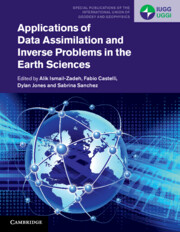Book contents
- Applications of Data Assimilation and Inverse Problems in the Earth Sciences
- Series page
- Applications of Data Assimilation and Inverse Problems in the Earth Sciences
- Copyright page
- Contents
- Contributors
- Preface
- Acknowledgements
- Part I Introduction
- Part II ‘Fluid’ Earth Applications: From the Surface to the Space
- Part III ‘Solid’ Earth Applications: From the Surface to the Core
- 11 Trans-Dimensional Markov Chain Monte Carlo Methods Applied to Geochronology and Thermochronology
- 12 Inverse Problems in Lava Dynamics
- 13 Data Assimilation for Real-Time Shake-Mapping and Prediction of Ground Shaking in Earthquake Early Warning
- 14 Global Seismic Tomography Using Time Domain Waveform Inversion
- 15 Solving Larger Seismic Inverse Problems with Smarter Methods
- 16 Joint and Constrained Inversion as Hypothesis Testing Tools
- 17 Crustal Structure and Moho Depth in the Tibetan Plateau from Inverse Modelling of Gravity Data
- 18 Geodetic Inversions and Applications in Geodynamics
- 19 Data Assimilation in Geodynamics: Methods and Applications
- 20 Geodynamic Data Assimilation: Techniques and Observables to Construct and Constrain Time-Dependent Earth Models
- 21 Understanding and Predicting Geomagnetic Secular Variation via Data Assimilation
- 22 Pointwise and Spectral Observations in Geomagnetic Data Assimilation: The Importance of Localization
- Index
- References
17 - Crustal Structure and Moho Depth in the Tibetan Plateau from Inverse Modelling of Gravity Data
from Part III - ‘Solid’ Earth Applications: From the Surface to the Core
Published online by Cambridge University Press: 20 June 2023
- Applications of Data Assimilation and Inverse Problems in the Earth Sciences
- Series page
- Applications of Data Assimilation and Inverse Problems in the Earth Sciences
- Copyright page
- Contents
- Contributors
- Preface
- Acknowledgements
- Part I Introduction
- Part II ‘Fluid’ Earth Applications: From the Surface to the Space
- Part III ‘Solid’ Earth Applications: From the Surface to the Core
- 11 Trans-Dimensional Markov Chain Monte Carlo Methods Applied to Geochronology and Thermochronology
- 12 Inverse Problems in Lava Dynamics
- 13 Data Assimilation for Real-Time Shake-Mapping and Prediction of Ground Shaking in Earthquake Early Warning
- 14 Global Seismic Tomography Using Time Domain Waveform Inversion
- 15 Solving Larger Seismic Inverse Problems with Smarter Methods
- 16 Joint and Constrained Inversion as Hypothesis Testing Tools
- 17 Crustal Structure and Moho Depth in the Tibetan Plateau from Inverse Modelling of Gravity Data
- 18 Geodetic Inversions and Applications in Geodynamics
- 19 Data Assimilation in Geodynamics: Methods and Applications
- 20 Geodynamic Data Assimilation: Techniques and Observables to Construct and Constrain Time-Dependent Earth Models
- 21 Understanding and Predicting Geomagnetic Secular Variation via Data Assimilation
- 22 Pointwise and Spectral Observations in Geomagnetic Data Assimilation: The Importance of Localization
- Index
- References
Summary
Abstract: Although many geophysical observations and models are available for the Tibetan Plateau (TP) and its surroundings regions, our knowledge and understanding of the uplift and deformation in the TP caused by the India–Asia collision is still incomplete. Due to the environmental complexity, the gravity method is indispensable to investigate the evolution of the TP. This study concentrates on the Moho depth and crustal density structure in the TP from gravity inversion of Bouguer anomalies. The results show Moho deeper than 60 km in the regions of the TP, suggesting thickening of the crust. Two sinking Moho belts in the southern and northern plateau regions and the linearly increasing Moho depth from the Indian Plate (IP) to the Indus-Yalu suture can be used to infer the crustal fold that has resulted from the India–Asia collision. On the other hand, the density structures show the lower density is commonly found in the crust and the underlying lithospheric mantle beneath the TP, contrasting with the high density in the surrounding blocks. Notably, the high density of the IP is observed underneath the Himalayas, suggesting that the Indian lithosphere extends northward, at least reaching the Indus-Yalu suture. Corresponding to the sinking Moho belts, the crustal densities in these regions present relatively low, which may be evidence for the absence of the eclogites in the lower crust beneath the Himalayas and the Lhasa terrane. In contrast, the relatively high densities underneath the Bangong-Nujiang suture are potentially contributions to the interpretation of the eclogitised lower crust.
Keywords
- Type
- Chapter
- Information
- Publisher: Cambridge University PressPrint publication year: 2023



